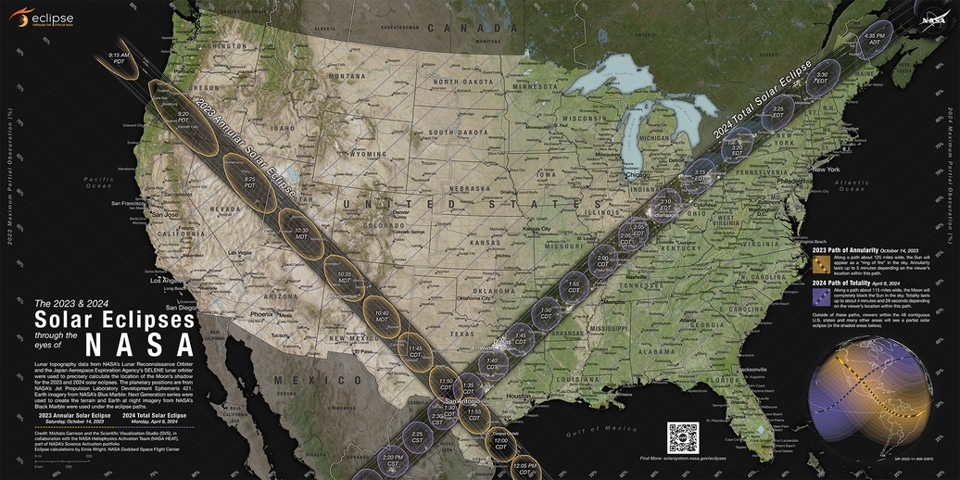NASA has issued a bunch of new high resolution maps to help eclipse-chasers plan where to be for two upcoming solar eclipses—both of which are visible in North America.
They show where the Moon’s shadow will cross the U.S. this October and in April 2024 during two very distinct kinds of solar eclipses. Both will cause a very significant partial solar eclipse for the whole of North America, but while the first one offers a view of a “ring of fire” from a narrow path the second one gives something way more precious—totality!
Whichever eclipse you’re planning for, know that the closer you are to the center of the eclipse path, the longer each eclipse will last. Each map also includes white lines that indicate how long that eclipse will last at different locations.
Here’s everything you need to know about these two landmark events:
October 14, 2023: ‘ring of fire’ annular solar eclipse
Best considered a warm-up event, an annular solar eclipse is effectively a nice-looking partial solar eclipse. So it will be very important to wear solar filters to protect eyes. An annular solar eclipse is caused by the Moon looking slightly smaller in the sky than the Sun (because it’s farthest from Earth on its egg-shaped orbit). So it only blocks the middle part of the Sun—hences a ring (annulus).
The 125 miles-wide path of annularity (ring-ness) will go from Oregon through Texas via Nevada, Utah and New Mexico, bringing a maximum five-minute “ring of fire” solar eclipse that will see 90% of the Sun blocked by the Moon.
The path includes a lot of US National Parks, including Crater Lake, Bryce Canyon, and Canyonlands. After exiting the U.S. the “ring of fire” will then visit Mexico’s Yucatan Peninsula, Belize, Honduras, Nicaragua, Panama, Colombia and Brazil.
April 8, 2024: total solar eclipse
Although the “ring of fire” will be fun, it will be a minor event compared to the “Great North American Eclipse” six months later. A 100 miles wide path of totality will surge across Mexico, the U.S and Canada, bringing a spectacular naked-eye totality lasting as long a 4 minutes 33 seconds.
After bringing totality to Sinaloa, Durango, and Coahuila in Mexico it will be the turn of the US, where Texas, Oklahoma, Arkansas, Missouri, Illinois, Kentucky, Tennessee, Michigan, Indiana, Ohio, Pennsylvania, New York, Vermont, New Hampshire and Maine will all receive an incredible sight—clear skies allowing. The Moon’s darkest shadow will fall on parts of Ontario, Quebec, New Brunswick, Prince Edward Island and Newfoundland. Here’s where to go watch it.
The last total solar eclipse in the US was the “Great American Eclipse” of 2017, though the next one isn’t until 2045.
The crossroads of the eclipses
Map geeks will love the fact that the two paths appear to cross. There’s little significance to this, though it’s interesting to note than this 100 square miles of Texas Hill Country—including the likes of Bandera, Kerrville, Uvalde and the Frio River—will get a “ring of fire” and totality inside six months.
America is living through a golden age of solar eclipse right now—but it won’t last long!
Disclaimer: I am the author of The Complete Guide To The Great North American Eclipse of April 8, 2024 and Editor of WhenIsTheNextEclipse.com
Wishing you clear skies and wide eyes.

